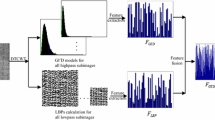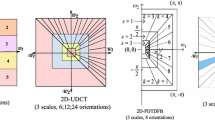Abstract
Local binary pattern (LBP) is an effective texture feature extraction algorithm, but sensitive to noise. This paper proposes an improved LBP algorithm named fusion center interval strategy (FCIS) for this problem. FCIS introduces the fuzzy method and presents an adaptive fusion center interval selection based on the local statistical information. To improve the completeness of feature extraction, a systematic texture feature extraction algorithm named the fusion feature wavelet pyramid (FFWP) has been proposed. FFWP is built on a set of flexible selectable filters of non-separable bidimensional Shannon type wavelets and fuses FCIS and gray-level co-occurrence matrix (GLCM). The FCIS and GLCM fusion features provide information on contrast, homogeneity, and local anisotropy. The wavelet pyramid with multi-level decomposition makes for multi-scale FCIS and GLCM fusion features with no need for the fixed radii. Validation experiments are performed on publicly available datasets, Kylberg, UMD, and UIUC datasets. Compared with 18 relative algorithms, the results show the effectiveness of FCIS with less time consumption and the supremacy of FFWP on robust and comprehensive texture representation.










Similar content being viewed by others
Explore related subjects
Discover the latest articles, news and stories from top researchers in related subjects.References
Gudadhe S, Thakare A, Oliva D (2023) Classification of intracranial hemorrhage ct images based on texture analysis using ensemble-based machine learning algorithms: A comparative study. Biomed Signal Process Control 84:104832. https://doi.org/10.1016/j.bspc.2023.104832
Hammad A, Shawkat A (2022) Applying modified LBP for 2D ECG images classification. In: Proceedings of the 2nd International Conference on Emerging Technologies and Intelligent Systems (ICETIS) 573, 22–31. https://doi.org/10.1007/978-3-031-20429-6_3
Kamireddy R, Dhuli R (2023) Detection of brain tumors from MR images using fuzzy thresholding and texture feature descriptor. J Supercomput 79:1–32. https://doi.org/10.1007/s11227-022-05033-x
Taneja K, Arora V, Verma K (2023) Classifying the heart sound signals using textural-based features for an efficient decision support system. Expert Syst 40(6). https://doi.org/10.1111/exsy.13246
Liu Q, Song Y, Tang Q, Bu X, Hanajima N (2023) Wire rope defect identification based on ISCM-LBP and GLCM features. Vis Comput, 1–13. https://doi.org/10.1007/s00371-023-02800-6
Liu H, Jia X, Su C, Yang H, Li C (2023) Tire appearance defect detection method via combining HOG and LBP features. Front Phys 10:1099261. https://doi.org/10.3389/fphy.2022.1099261
Yuan H, Lei Z, You X, Dong Z, Zhang H, Zhang C, Zhao Y, Liu J (2023) Fault diagnosis of driving gear in rack and pinion drives based on multi-scale local binary pattern extraction and sparse representation. Meas Sci Technol 34(5). https://doi.org/10.1088/1361-6501/acbab4
Karanwal S, Diwakar M (2023) Triangle and orthogonal local binary pattern for face recognition. Multimed Tools Appl, 1–27. https://doi.org/10.1007/s11042-023-15072-y
Mathew D, Kumar DCS, Cherian KA (2023) Integration of nondecimated quaternion wavelet transform and neighborhood texture patterns for disease classification in banana (musa spp.) foliage. Multimed Tools Appl, 1–23. https://doi.org/10.1007/s11042-023-14869-1
Bakheet S, Alsubai S, El-Nagar A, Alqahtani A (2023) A multi-feature fusion framework for automatic skin cancer diagnostics. Diagnostics 13(8):1474. https://doi.org/10.3390/diagnostics13081474
Sut S, Koc M, Zorlu G, Serhatlioglu I, Barua PD, Dogan S, Baygin M, Tuncer T, Tan RS, Acharya UR (2023) Automated adrenal gland disease classes using patch-based center symmetric local binary pattern technique with CT images. J Digit Imaging 36:1–14. https://doi.org/10.1007/s10278-022-00759-9
Chen H, Ma M, Liu G, Wang Y, Jin Z, Liu C (2023) Breast tumor classification in ultrasound images by fusion of deep convolutional neural network and shallow LBP feature. J Digit Imaging 36:1–15. https://doi.org/10.1007/s10278-022-00711-x
Haralick R, Shanmugam K, Dinstein I (1973) Textural features for image classification. IEEE Trans Syst Man Cybern 3(6):610–621
Zhu Y, Zhao L, Chen X, Li Y, Wang J (2023) Identification of cashmere and wool based on LBP and GLCM texture feature selection. J Eng Fibers Fabr 18. https://doi.org/10.1177/15589250221146548
Fernández A, Álvarez Cid M, Bianconi F (2013) Texture description through histograms of equivalent patterns. J Math Imaging Vis 45(1):76–102. https://doi.org/10.1007/s10851-012-0349-8
Ojala T, Pietikainen M, Harwood D (1996) A comparative study of texture measures with classification based on featured distributions. Pattern Recognit 29(6):51–59. https://doi.org/10.1016/0031-3203(95)00067-4
Li B, Li Y, Wu QMJ (2023) A completed parted region local neighborhood energy pattern for texture classification. Dig Signal Process 137:104031. https://doi.org/10.1016/j.dsp.2023.104031
Lan S, Fan H, Hu S, Ren X, Liao X, Pan Z (2023) An edge-located uniform pattern recovery mechanism using statistical feature-based optimal center pixel selection strategy for local binary pattern. Expert Syst Appl 221:119763. https://doi.org/10.1016/j.eswa.2023.119763
Akbal E, Barua PD, Dogan S, Tuncer T, Acharya UR (2023) Explainable automated anuran sound classification using improved one-dimensional local binary pattern and tunable Q wavelet transform techniques. Expert Syst Appl 225:120089. https://doi.org/10.1016/j.eswa.2023.120089
Tan X, Triggs B (2010) Enhanced local texture feature sets for face recognition under difficult lighting conditions. IEEE Trans Image Process 23(6):1635–1650
Song K-C, Yan Y, Zhao Y, Liu C (2015) Adjacent evaluation of local binary pattern for texture classification. J Vis Commun Image Represent 33:323–339. https://doi.org/10.1016/j.jvcir.2015.09.016
Iakovidis D, Keramidas E, Maroulis D (2008) Fuzzy local binary patterns for ultrasound texture characterization. Int Conf Image Anal Recognit 5112(6):750–759. https://doi.org/10.1007/978-3-540-69812-8_74
Liu L, Long Y, Fieguth P, Lao S-Y, Zhao G (2014) BRINT: binary rotation invariant and noise tolerant texture classification. IEEE Trans Image Process 23(7):3071–3084. https://doi.org/10.1109/TIP.2014.2325777
Zhao Y, Jia W, Hu R-X, Hai M (2013) Completed robust local binary pattern for texture classification. Neurocomputing 106:68–76. https://doi.org/10.1016/j.neucom.2012.10.017
Luo Y, Sa J, Song Y, Jiang H, Zhang C, Zhang Z (2023) Texture classification combining improved local binary pattern and threshold segmentation. Multimed Tools Appl 82:1–18. https://doi.org/10.1007/s11042-023-14749-8
Wang K, Bichot C-E, Li Y, Li B (2017) Local binary circumferential and radial derivative pattern for texture classification. Pattern Recognit 67:213–229. https://doi.org/10.1016/j.patcog.2017.01.034
Guo Z, Zhang L, Zhang D (2010) A completed modeling of local binary pattern operator for texture classification. IEEE Trans Image Process 19(6):1657–1663. https://doi.org/10.1109/TIP.2010.2044957
Zhao Y, Huang D-S, Jia W (2012) Completed local binary count for rotation invariant texture classification. IEEE Trans Image Process 21(10):4492–4497. https://doi.org/10.1109/TIP.2012.2204271
Arora N, Sharma S (2023) The practical applications of HLBP texture descriptor. Multimed Tools Appl. https://doi.org/10.1007/s11042-023-14406-0
Qian X, Hua X-S, Chen P, Ke L (2011) PLBP: an effective local binary patterns texture descriptor with pyramid representation. Pattern Recognit 44:2502–2515. https://doi.org/10.1016/j.patcog.2011.03.029
Wu X, Sun J (2017) Joint-scale LBP: a new feature descriptor for texture classification. Vis Comput 33(3):317–329. https://doi.org/10.1007/s00371-015-1202-z
Koley S, Roy H, Dhar S, Bhattacharjee D (2023) Cross-modal face recognition with illumination-invariant local discrete cosine transform binary pattern (LDCTBP). Pattern Anal Appl 26:1–13. https://doi.org/10.1007/s10044-023-01139-x
Pan Z, Li Z, Fan H, Wu X (2017) Feature based local binary patterns for rotation invariant texture classification. Expert Syst Appl 88:238–248. https://doi.org/10.1016/j.eswa.2017.07.007
Xu X, Li Y, Wu QMJ (2020) A completed local shrinkage pattern for texture classification. Appl Soft Comput 97(B):106830. https://doi.org/10.1016/j.asoc.2020.106830
Xu X, Li Y, Wu QMJ (2021) A compact multi-pattern encoding descriptor for texture classification. Dig Signal Process 114(2):103081. https://doi.org/10.1016/j.dsp.2021.103081
Pan Z, Hu S, Wu X, Wang P (2021) Adaptive center pixel selection strategy to local binary pattern for texture classification. Expert Syst Appl 180(4):115–123. https://doi.org/10.1016/j.eswa.2021.115123
Mallat S (1989) A theory of multiresolution signal decomposition: the wavelet representation. IEEE Trans Pattern Anal Mach Intell 11(4):674–693. https://doi.org/10.1109/34.192463
Tymczak C, Niklasson A, Roder H (2002) Separable and nonseparable multiwavelets in multiple dimensions. J Comput Phys 175(2):363–397. https://doi.org/10.1006/jcph.2001.6743
Feauveau JC (1990) Analyse Multirésolution Par Ondelettes Nonorthogonale et Benes de Filtres Numériques. PhD. Thesis, Université de Paris Sud
Kovačević J, Vetterli M (1991) Nonseparable multidimensional perfect reconstruction filter banks and wavelet bases for \(\mathbb{R} ^n\). IEEE Trans Inf Theory 38(2):533–555
Cohen A, Daubechies I (1993) Non-separable bidimensional wavelet bases. Revista Matematica Iberoamericana 9(1):51–137. https://doi.org/10.4171/RMI/133
Wouwer GVD, Scheunders P, Dyck D (1998) Rotation-invariant texture characterization using isotropic wavelet frames. Int Conf Pattern Recognit IEEE 1:814–816. https://doi.org/10.1109/ICPR.1998.711273
Movassagh AA, Alzubi J, Gheisari M, Rahimi M, Mohan S, Abbasi A, Nabipour N (2021) Artificial neural networks training algorithm integrating invasive weed optimization with diferential evolutionary model. J Ambient Intell Hum Comput 14. https://doi.org/10.1007/s12652-020-02623-6
Alzubi O, Qiqieh I, Alzubi J (2022) Fusion of deep learning based cyberattack detection and classification model for intelligent systems. Cluster Comput 26. https://doi.org/10.1007/s10586-022-03686-0
Alzubi O, Alzubi J, Alweshah M, Qiqieh I, Al-Shami S, Manikandan R (2020) An optimal pruning algorithm of classifier ensembles: dynamic programming approach. Neural Comput Appl 32:1–17. https://doi.org/10.1007/s00521-020-04761-6
Alzubi J (2015) Optimal classifier ensemble design based on cooperative game theory. Res J Appl Sci Eng Technol 11(12):1336–1346. https://doi.org/10.19026/rjaset.11.2241
Kylberg G (2011) The kylberg texture dataset. Centre for Image Analysis, Swedish University of Agricultural Sciences and Uppsala University, External report (Blue series) No. 35
Xu Y, Yang X, Ling H, Ji H (2010) A new texture descriptor using multifractal analysis in multi-orientation wavelet pyramid. In: The 2010 IEEE Conference on Computer Vision and Pattern Recognition (CVPR), 161–168 . https://doi.org/10.1109/CVPR.2010.5540217
Lazebnik S, Schmid C, Ponce J (2005) A sparse texture representation using local affine regions. IEEE Trans Pattern Anal Mach Intell 27(8):1265–1278. https://doi.org/10.1109/TPAMI.2005.151
Cimpoi M, Maji S, Kokkinos I, Vedaldi A (2016) Deep filter banks for texture recognition, description, and segmentation. Int J Comput Vis 118:65–94. https://doi.org/10.1007/s11263-015-0872-3
Ojala T, Pietikainen M, Maenpaa T (2002) Multiresolution gray-scale and rotation invariant texture classification with local binary patterns. IEEE Trans Pattern Anal Mach Intell 24(7):971–987. https://doi.org/10.1109/TPAMI.2002.1017623
Dai X, Diao Y, Xin J (2010) Multipliers, phases and connectivity of MRA wavelets in \({L}^2(\mathbb{R} ^2)\). J Fourier Anal Appl 16:155–176. https://doi.org/10.1007/s00041-009-9089-6
Lagarias J, Wang Y (1998) Haar type orthonormal wavelet basis in \(\mathbb{R} ^2\). J Fourier Anal Appl 2(1):1–14
Daubechies I (1992) Ten Lecture on Wavelets, vol 61. Society for Industrial and Applied, SIAM, Philadelphia
Meyer Y (1995) Wavelets and Operators vol. 37. Cambridge Studies in Advanced Mathematics, Cambridge University Press, Cambridge
Cortes C, Vapnik V (1995) Support-vector networks. Mach Learn 20(3):273–297
Acknowledgements
This work was supported by National Key R &D Program of China (2020YFB1707802), National Natural Science Foundation of China (No.12071131, No.11571107), a project funded by the China Postdoctoral Science Foundation (Grant No. 2020M680480) and Natural Science Foundation of Hebei Province, China (F2021201020). The authors thank the anonymous referees for their helpful comments and suggestions that helped us improve the presentation of this paper.
Author information
Authors and Affiliations
Corresponding author
Additional information
Publisher's Note
Springer Nature remains neutral with regard to jurisdictional claims in published maps and institutional affiliations.
Rights and permissions
Springer Nature or its licensor (e.g. a society or other partner) holds exclusive rights to this article under a publishing agreement with the author(s) or other rightsholder(s); author self-archiving of the accepted manuscript version of this article is solely governed by the terms of such publishing agreement and applicable law.
About this article
Cite this article
Su, H., Chen, J., Li, Z. et al. The fusion feature wavelet pyramid based on FCIS and GLCM for texture classification. Int. J. Mach. Learn. & Cyber. 15, 1907–1926 (2024). https://doi.org/10.1007/s13042-023-02005-2
Received:
Accepted:
Published:
Issue Date:
DOI: https://doi.org/10.1007/s13042-023-02005-2
Keywords
- Texture classification
- Local binary pattern (LBP)
- Gray-level co-occurrence matrix (GLCM)
- Fusion center interval strategy (FCIS)
- Fusion feature wavelet pyramids (FFWP)




